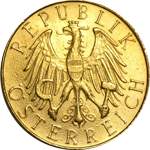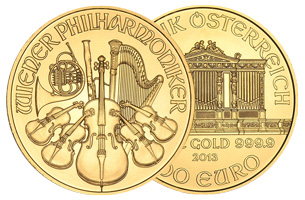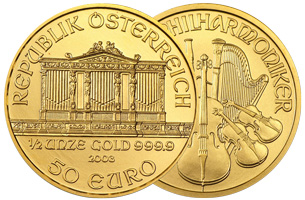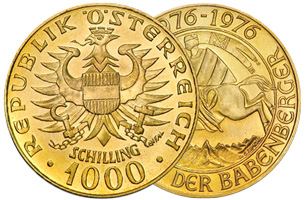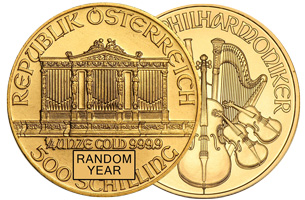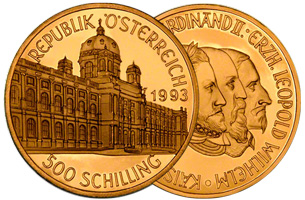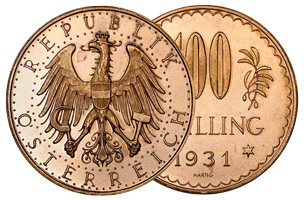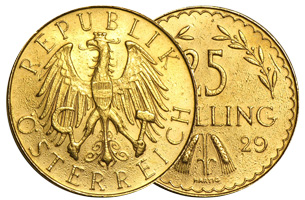The Schilling was the official currency of Austria from 1924 to 1938 and from 1945 to 1999. The first Schilling was introduced by the Schilling Act in December, 1924 at a rate of 1 Schilling to 10,000 Austro-Hungarian Kronen and released in March of the following year. Between 1938 and 1945, Schilling was replaced by the German Reichsmark in the wake of the Anschluss. After World War I, the Schilling was re-introduced by the Allied Military at the exchange rate of 1:1 to the Reichsmark. In 1999, the Schilling was abolished for the Euro, the official currency of the Eurozone (the Schilling still circulated until 2002).
The first Schilling coins were made of bronze, cupro-nickel and silver. The second Schilling, however, was struck in aluminum. In 1957, the silver 10 schilling coins were introduced, followed by the aluminum-bronze 1 schilling in 1959, and the silver 5 schilling in 1960. This unusual transition from aluminum to silver was enabled by Austria’s significant economic improvement in the 1950s. However, the 5 and the 10 silver schilling coins were replaced by cupro-nickel in 1969 and 1974, respectively. In 1980, an aluminum-bronze 20 schilling coin was introduced. In total, Austria produced 25, 50, 100, 200, and 500 silver schilling coin. The Austrian Mint also struck gold 25, 100, 200, 500, 1000, and 2000 schilling coins, although they were rarely used for actual transactions.
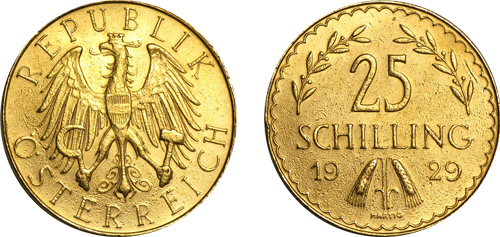
Gold 25 schilling coins were issued from 1926 to 1938. It has been estimated that 276,705 gold 25 schilling coins were minted during that period. The obverse side shows the Imperial Eagle of the Austrian Republic, holding a sickle (to represent agriculture) and a hammer (to represent industry) in each talon. The eagle’s breast is covered with an Austrian shield. The words “REPUBLIK ÖSTERREICH” (“REPUBLIC OF AUSTRIA”) are surrounding the eagle. The reverse side features the denomination “25 SCHILLING” between two edelweiss sprays, as well as the mint year at the bottom divided by wheat springs. The name of the coin designer Hartig in small letters can be found at the bottom of the coin, too. There is another obverse design that features St. Leopold, the patron saint of Austria, on plinth, holding banner with arms of Lower Austria and a model Abbey. The St. Leopold coin was issued by the Austrian Mint from 1935 to 1938.
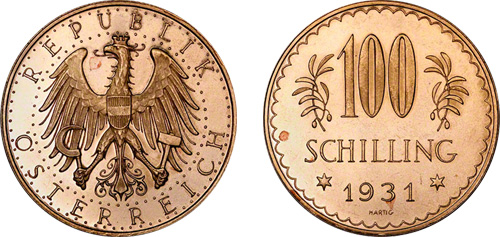
The gold 100 schilling coin was minted from 1926 to 1938. There were less than 390, 000 of these coins minted during those years. The design of the 100 schilling coin is very similar to the 25 schilling coin. The obverse side features the denomination “100 SCHILLING” between two edelweiss sprays. However, the mint year on this coin is flanked by two stars. The reverse design is identical to the 25 schilling coin.
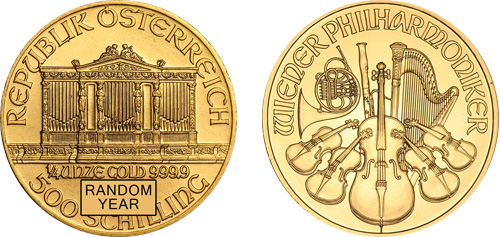
The gold 500 schilling coin was produced by the Austrian Mint to commemorate several events in Austrian history or otherwise significant events. The gold 500 schilling coin is a pure gold coin and is known to be highly artistic and supremely produced. Each issue has a unique design. The gold 500 schilling coins commemorate the Emperors Rudolf II, Ferdinand II, and Archduke Leopold Wilhelm (1993), the Congress of Vienna (1994), Heinrich II Jasomirgott (1996), as well as the Vienna Boys Choir (1998). From 1989 to 2001, the Austrian Mint issued a 500 schilling pure gold coin which pays tribute to Vienna’s Philharmonic Orchestra. The obverse side shows the great organ in the Golden Hall in Vienna’s Musikverein, the concert hall of the Vienna Philharmonic Orchestra, the face value in schilling, the weight, alloy purity, and mint year. The reverse design features musical instruments representing the Vienna Philharmonic Orchestra, as well as the inscription WIENER PHILHARMONIKER (“VIENNA PHILHARMONIC”). The Vienna Philharmonic was also denominated as 200 schilling, 1000 schilling, and 2000 schilling (until Austria’s adoption of the Euro in 2002).
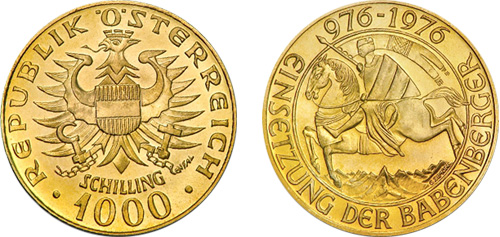
In 1976, the Austrian Mint issued a gold 1000 schilling coin to commemorate the 1,000 anniversary of the start of the Babenberg Dynasty. It was the first time the Austrian Mint ever produced a coin with such a high face value. The obverse design of the coin features the Imperial Eagle whose breast is covered with an Austrian shield and which holds a hammer and a sickle in its talons. Beneath the eagle is the denomination “1000 SCHILLING.” The words “REPUBLIK ÖSTERREICH” (“REPUBLIC OF AUSTRIA”) is surrounding the eagle. The reverse depicts the Seal of Duke Friedrich II: a knight carrying a pennant on horseback. The dates of the anniversary (976-1976) and the words “EINSETZUNG DER BABENBERGER” encircle the seal. While the obverse side was created by Martha Coufal-Hartl, the reverse was designed by Gertrude Simon. However, there have been at least eleven different designs and types of gold 1000 schilling coin, as well as at least seven different specifications. For instance, the Austrian mint issued gold 1000 schilling coins commemorating the Olympic Games, Empress Maria Theresia or the Second Republic.
The gold 25, 100 schilling and Babenberg Dynasty 1000 coins are made of 90% gold, while the gold 500 schilling coins and the Vienna Philharmonic 200, 500, 1000, and 2000 are made of 99% gold.
Any gold schilling coins is a supreme investment vehicle. The Austrian Mint is one of the most reputable mints in the world, known for their unmatched artistry and craftsmanship. Whether you decide to acquire the 25, 100, 200, 500, 1000 or even 2000 schilling coin, the gold schilling will be a fantastic addition to your precious metal portfolio.

